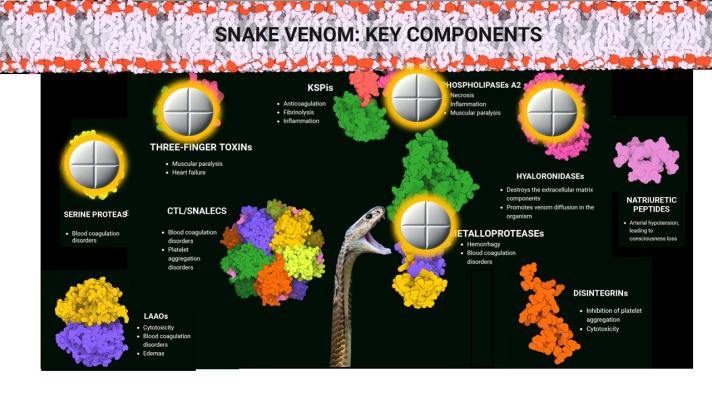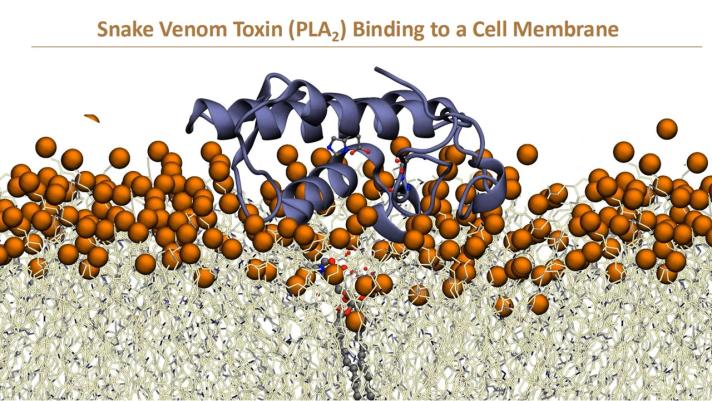Prof Pedro Alexandrino Fernandes is working to solve a problem that has been affecting humanity for time immemorial – snakebite envenoming. Records going as far back as 4000 years, from Egyptian times, detail the challenge of saving people from deadly snakebites which still cause between 81,000 and 140,000 deaths globally annually. The World Health Organisation (WHO) has set the goal of reducing snakebite deaths by 50 percent by 2030. EuroHPC compute power is now helping to address this public health challenge thanks to Vega, our Slovenian High Performance Computing. By simulating the toxins found in snake venom, the project has been able to measure the impact on human cells. This new knowledge may hold the key to discovering accessible drugs to counter the effects of snake bite poisoning.
Why anti-venoms have not solved the problem.
If delivered in time, snakebite antidotes (also known as anti-venoms) can save the lives of people who experience snakebites. The situation is not, however, improving and deaths from snakebite, especially in the most deprived parts of the world, are still high.
Anti-venoms are costly and complex to produce. The process to develop an anti-venom is lengthy and expensive. Most venoms are produced by extracting antibodies from horses who have developed immunity over 6 to 8 months of being exposed to the venom. The average anti-venom treatment can cost anywhere between €5000 and €50,000.
Once the antidote is ready to use, it needs to be distributed to areas of the world where snake bites are more prevalent. Anti-venoms require “cold-chain” storage and have a short shelf life. Anti-venoms need to be administered by qualified staff in medical centres with stable electricity supplies (for cold storage) because of the very high chance of an anaphylactic reaction. This leads to supply issues in areas of the world where people are most likely to get bitten.
Poisonous frogs and fish usually only have one active substance inside their venom, but this is not the case for snakes. Developing one single antidote for all types of snake venom has not yet been achieved as venoms vary from one snake species to another. Snake venom is made up of a complex cocktail of deadly venoms that attack the body in different ways (Fig 1). For all these reasons, the development of an accessible solution, especially for those living and working in the poorest regions of the world, is critical.
A global team and a radical new approach
Professor Fernandes, from the University of Porto in Portugal, is working with a global team of researchers from Costa Rica, Brazil, the United Kingdom, South Africa, the United States and India, who are all focused on solving this terrible problem. A critical component of the research was determining the reaction processes of two principal snake venom enzymes (PLA2 and HYA). This work was far too computationally demanding to be carried out on a national cluster and required the CPU capabilities of a world-class supercomputer. With his partners, Professor Fernandes applied to EuroHPC JU for time on the Vega supercomputer (located in Slovenia and operated by IZUM) and received more than 24,000,000 core hours.
Thanks to Vega, the research team was able to figure out how components of the venom attack the human body by simulating the effect at a cellular level (See Fig 2). As a result, the research team now understands in much greater detail how each component of the venom destroys cells and cause paralyses and even death. With this new information, they can now design pharmaceutical compounds which have the potential to act as toxin inhibitors. From the millions of compounds tested, the team selected around one hundred powerful candidate molecules to be examined in the lab at the Liverpool School of Tropical Medicine.
The winning combination of supercomputing and chemistry now provides a real pathway to finding an affordable and effective treatment for snakebite envenoming. These treatments are being designed specifically for people such as farmers working in remote rural areas. An ideal outcome is to produce a pill that will not require cold-storage or administration in a hospital.
The scientists hope that this research will dramatically reduce the level of preventable deaths caused by snakebites. Their scientific knowledge and dedication combined with access to EuroHPC infrastructure offers a real hope to save hundreds of thousands of lives through new lifesaving drug. EuroHPC JU will continue to support this groundbreaking work. In February 2025 the research team were awarded an additional 260,000 node hours on Discoverer CPU.
If you would like to hear Prof Fernandes talk about this project, you can access the EuroHPC 2025 Summit Live Stream on Showcasing Scientific and Societal Breakthroughs on EuroHPC Supercomputers:
Murderous Venom - An Universal and Affordable Antidote Against Snakebite



